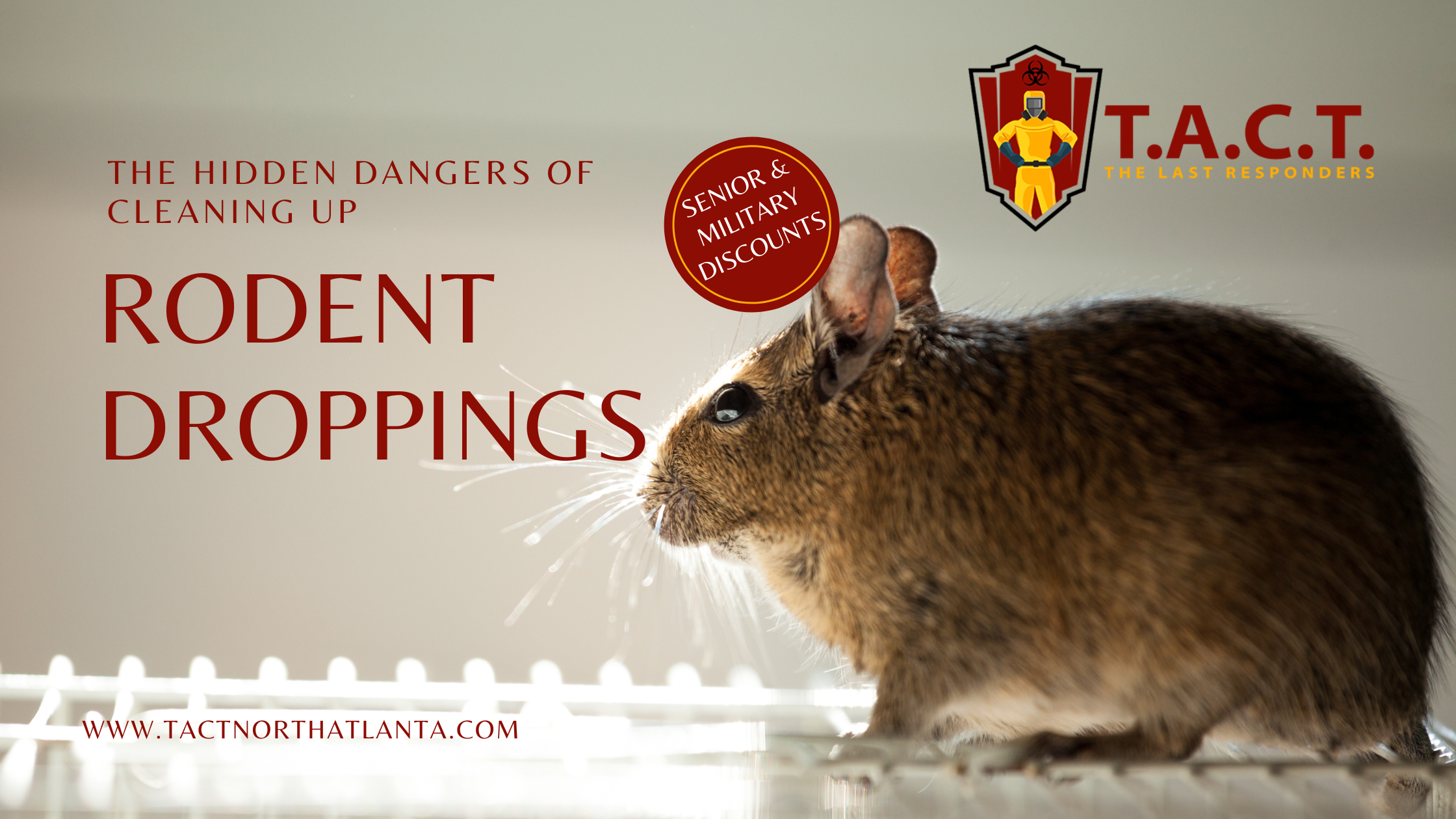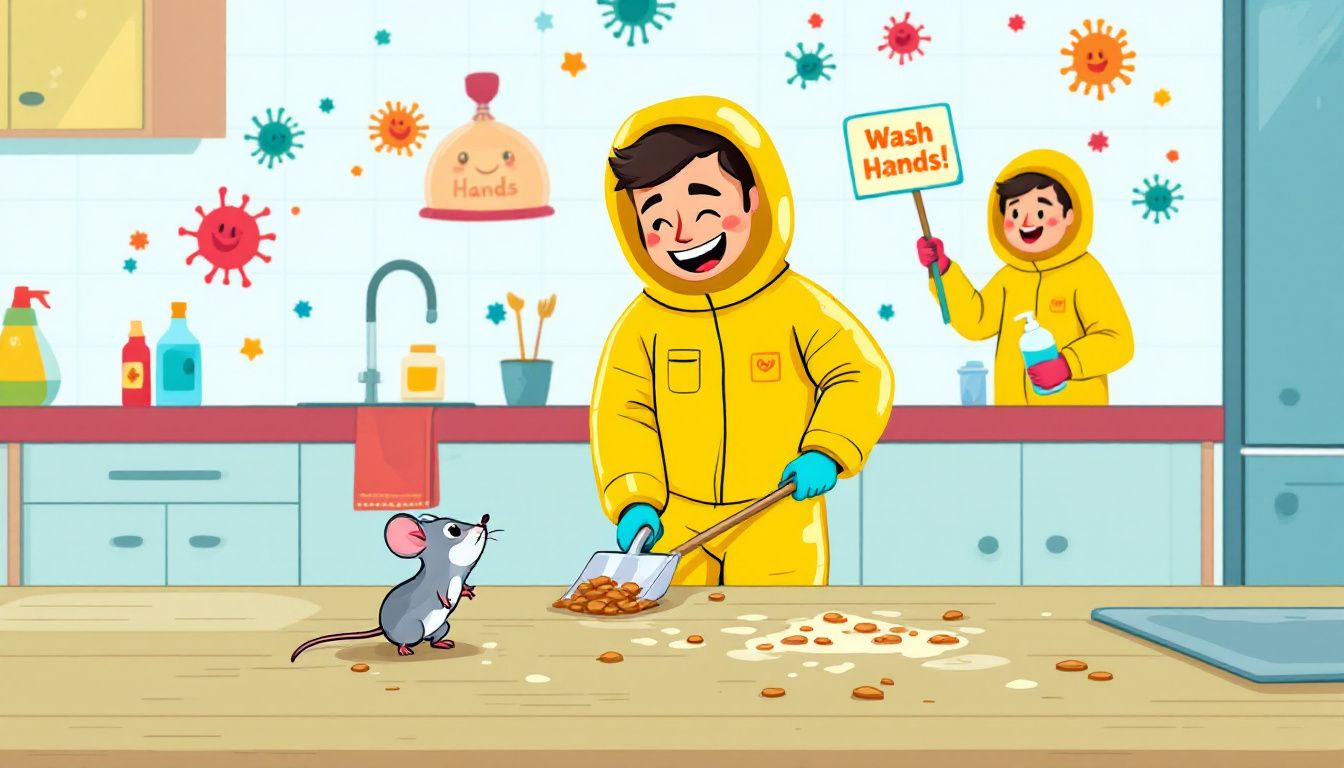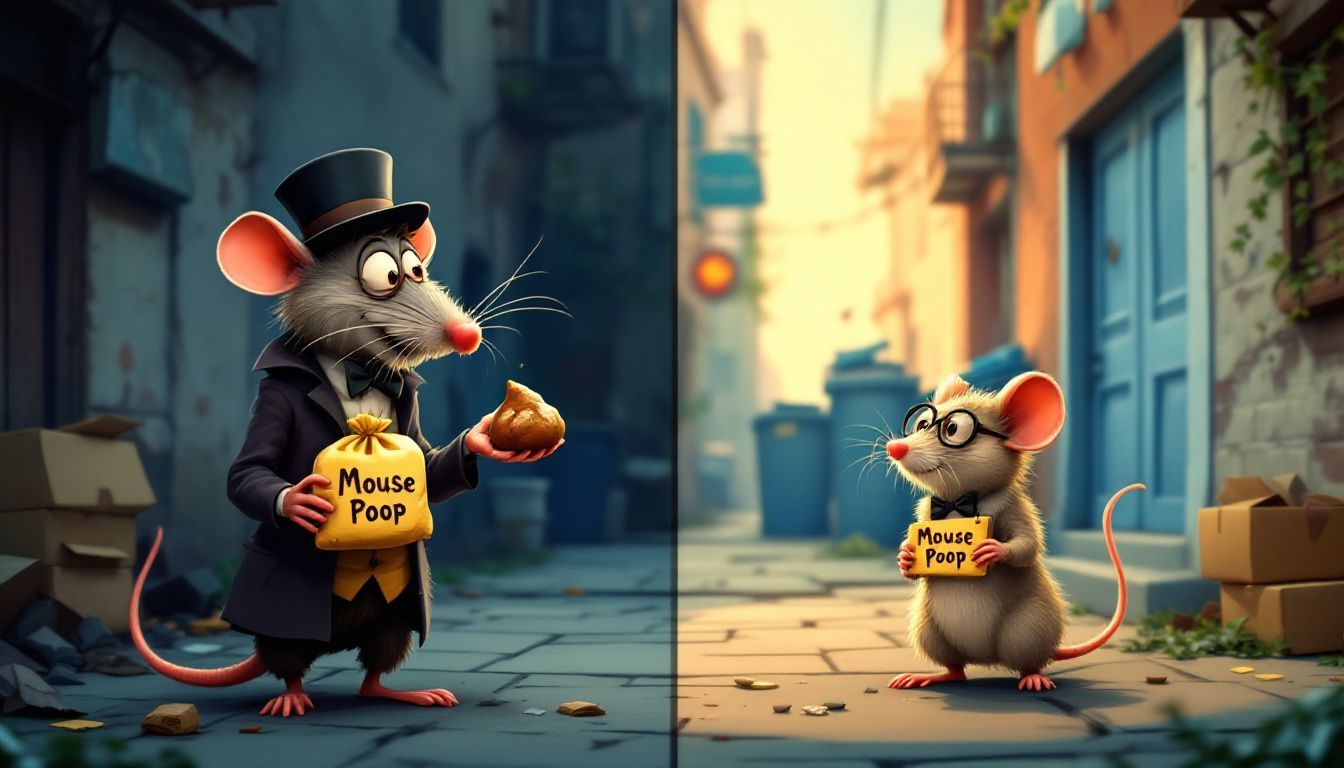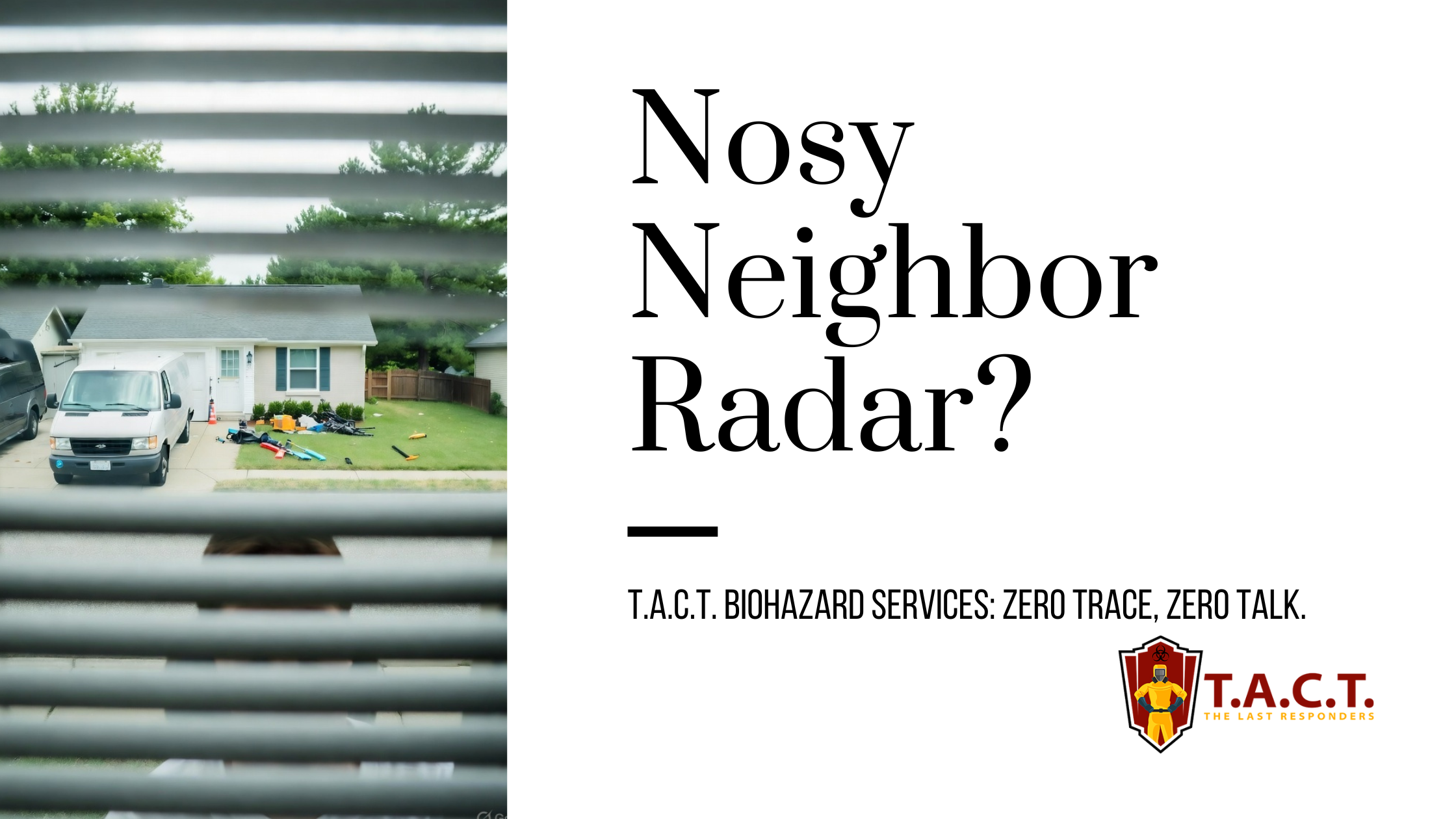mice poop

Mice Poop: How to Identify and Safely Clean Up Rodent Droppings
Found mouse droppings? Learn how to identify and manage a mouse infestation, understand health risks, and safely clean up in this guide.
Key Takeaways
Mouse droppings are small, dark pellets that indicate rodent activity and can be differentiated based on freshness and location.
Handling mouse droppings poses health risks, including the transmission of serious diseases; proper protective measures are essential during cleanup.
Preventing mouse infestations involves sealing entry points, eliminating food sources, and using traps effectively.
Identifying Mice Poop

Mouse droppings are one of the clearest signs of a rodent problem. Finding mouse droppings, recognizing these small, dark pellets, can help you take swift action to address a potential infestation.
Appearance of Mouse Droppings
Mouse droppings are usually small and dark. They often resemble grains of rice. They are about 1/8 inch in diameter, and their color ranges from black to dark brown. The granular, pellet-like shape is a distinctive feature, making it easier to identify mouse droppings compared to those of other rodents.
Fresh vs. Old Mouse Droppings
Differentiating between fresh and old mouse droppings helps assess the level of activity. Fresh mouse droppings are black and shiny, indicating recent activity. Over time, these droppings turn gray and become crumbly, which helps to identify older droppings.
Accurate identification is crucial for effective cleanup and minimizing health risks.
Common Locations for Mouse Droppings
Mouse droppings are commonly found along paths traveled by mice and near food sources. Kitchens, cabinets, attics, and behind furniture are frequent hotspots for these droppings. A single mouse can leave behind 50-75 pellets per day, indicating high levels of activity. Nesting materials, such as shredded paper or fabric, are also often found in these areas and can indicate the presence of mice, as they suggest suitable living conditions for rodents.
These areas are crucial for monitoring and controlling mouse populations.
Health Risks Associated with Mouse Droppings
Mouse droppings are not just a nuisance; they can pose serious health risks. Being aware of these risks helps protect your home and family.
Diseases Spread by Rodent Droppings
Rodent droppings can spread various diseases, including hantavirus pulmonary syndrome, salmonellosis, and rat feces. These diseases can be transmitted by inhaling dust contaminated by mouse poop, rodent's urine, or rodent feces. Severe cases of these illnesses can be fatal if untreated. Rodents such as deer mice and rice rats can carry hantavirus, making it essential to handle droppings with care.
Symptoms of Rodent-Borne Diseases
Early symptoms of rodent-borne diseases include fever, muscle aches, and fatigue. Timely medical intervention relies on recognizing these symptoms. If you experience these symptoms after exposure to rodent droppings, seek medical attention immediately.
Preventing Disease Transmission
To prevent disease transmission when handling mouse droppings, wear rubber gloves and avoid touching your face. Always wash your hands with soap and water after handling contaminated materials.
These precautions help prevent disease transmission.
Safe Cleaning Practices for Mouse Droppings

Adopting proper cleaning practices ensures safe removal of mouse droppings and minimizes health risks.
Preparing for Cleanup
Ventilate the area by opening windows and doors for at least 30 minutes before starting the cleanup. Wear long-sleeve shirts, gloves, and masks to protect yourself from contaminants.
Cleaning Process
Gather your cleaning supplies, including disinfectants, paper towels, and plastic bags. Use a disinfectant solution to wet the droppings for five minutes before wiping them up with a plastic bag to safely contain the contaminated materials. Avoid sweeping or vacuuming, as this can aerosolize harmful pathogens.
Disposing of Contaminated Materials
Double-bag contaminated materials in plastic bags to prevent exposure. Dispose of these materials in a covered trash can to minimize health risks.
For nests contaminated with droppings, spray them with bleach water, wait, and then double-bag before disposal.
Preventing Future Infestations

Preventing future infestations is crucial to maintaining a pest control rodent-free home.
Sealing Entry Points
Rodents can enter through gaps around pipes, vents, and utility lines. Seal these entry points to prevent rodents from entering your home.
Use materials such as steel wool, caulk, or expanding foam to seal gaps and prevent mouse access.
Eliminating Food Sources
Store pet food in secured containers to prevent attracting rodents. Removing food sources is key to preventing rodent infestations.
Using Traps and Bait Stations
Using mechanical traps, such as snap traps, is an effective method for catching mice. Place traps along common pathways where rodent activity is noted.
Follow safety guidelines when using traps to avoid harming pets or humans.
Rat Poop vs. Mouse Poop

Identifying the type of rodent droppings is crucial for determining the rodent issue at hand.
Differences in Size and Shape
Mouse droppings are typically around 1/4 inch long, making them smaller than rat droppings. Mouse droppings have a more tapered shape compared to the broader ends of rat droppings.
Implications of Different Rodent Infestations
Rat infestations often require more intensive control efforts due to their larger size and aggressive behavior compared to house mice. Mice tend to create smaller, less noticeable nests, making mice infestation harder to detect.
Understanding the behavioral patterns of both rodents aids in selecting effective traps and bait for extermination.
Signs of an Ongoing Infestation
Keep an eye out for new signs of rodent activity to address ongoing infestations.
Monitoring for New Droppings
If mouse droppings are continuously found, it indicates ongoing rodent activity. Regularly check common nesting areas to detect new droppings.
After treatment, residents should expect to stop seeing mice within one or two weeks.
Other Indicators of Rodent Activity
Other signs of rodent activity include visible indicators like gnaw marks on furniture or walls and the presence of urine stains in various locations. These indicators, along with droppings, can help you determine the extent of the infestation.
Summary
Summarize the key points covered in the guide, emphasizing the importance of identifying, cleaning, and preventing rodent infestations. Encourage readers to take action and maintain a rodent-free home.
Frequently Asked Questions
What do mouse droppings look like?
Mouse droppings appear as small, dark grains resembling rice, usually around 1/8 inch in diameter. Identifying them early can help prevent potential infestations.
How can I tell if mouse droppings are fresh or old?
You can tell fresh mouse droppings from old ones by their appearance; fresh droppings are black and shiny, whereas older droppings are gray and crumbly.
Where am I likely to find mouse droppings in my home?
You are likely to find mouse droppings in kitchens, cabinets, attics, and behind furniture. Checking these areas regularly can help in identifying and addressing potential infestations.
What are the health risks associated with mouse droppings?
Mouse droppings pose serious health risks, including the transmission of diseases like hantavirus pulmonary syndrome, salmonellosis, and rat bite fever. It's vital to handle them with care to prevent potential health hazards.
How do I safely clean up mouse droppings?
To safely clean up mouse droppings, wear rubber gloves and ventilate the area. Use a disinfectant to wet the droppings for five minutes before carefully wiping them up, avoiding sweeping or vacuuming to prevent spreading airborne pathogens.
Latest news

Nosy neighbors peeking? T.A.C.T. North Atlanta offers discreet biohazard remediation for rodent infestations, mold, hoarding, and more. Unmarked vehicles, quiet experts, full privacy—24/7 service at 470-781-4775.
Read More

